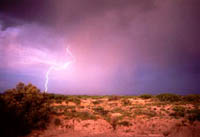Thunderstorms

While thunder won't hurt you-lightning will! So it's important to pay attention when you hear thunder. Thunderstorms happen in every state, and every thunderstorm has lightning. Lightning can strike people and buildings and is very dangerous.
Thunderstorms affect small areas when compared with hurricanes and winter storms. The typical thunderstorm is 15 miles in diameter and lasts an average of 30 minutes. Nearly 1,800 thunderstorms are happening at any moment around the world. That's 16 million a year!
 |
Despite their small size, all thunderstorms are dangerous. Every thunderstorm produces lightning, which kills more people each year than tornadoes. Strong winds, hail, and tornadoes are also dangers associated with some thunderstorms.
You can estimate how many miles away a storm is by counting the number of seconds between the flash of lightning and the clap of thunder. Divide the number of seconds by five to get the distance in miles. The lightning is seen before the thunder is heard because light travels faster than sound.
Thunderstorms need three things:
- Moisture-to form clouds and rain.
- Unstable Air-relatively warm air that can rise rapidly.
- Lift-fronts, sea breezes and mountains are capable of lifting air to help form thunderstorms.
Thunderstorms are most likely to occur in the spring and summer months and during the afternoon and evening hours, but they can occur year-round and at all hours of the day or night. Thunder and lightning can sometimes even come with a snowstorm!
A severe thunderstorm watch is issued by the National Weather Service when the weather conditions are such that a severe thunderstorm is likely to develop. (A severe thunderstorm has winds at least 58 miles per hour or hail at least three-fourths of an inch in diameter.) A severe thunderstorm warning is issued when a severe thunderstorm has been sighted or indicated by weather radar. A warning is more severe than a watch.
More Facts about thunderstorms:
- Thunderstorms may occur singly, in clusters, or in lines.
- Some of the most severe occur when a single thunderstorm affects one location for an extended time.
- Thunderstorms typically produce heavy rain for a brief period, anywhere from 30 minutes to an hour.
- Warm, humid conditions are highly favorable for thunderstorm development.
- About 10 percent of thunderstorms are classified as severe-one that produces hail at least three-quarters of an inch in diameter, has winds of 58 miles per hour or higher, or produces a tornado.
Source: Federal Emergency Management Agency (FEMA)
Fact Monster/Information Please® Database, © 2007 Pearson Education, Inc. All rights reserved.
